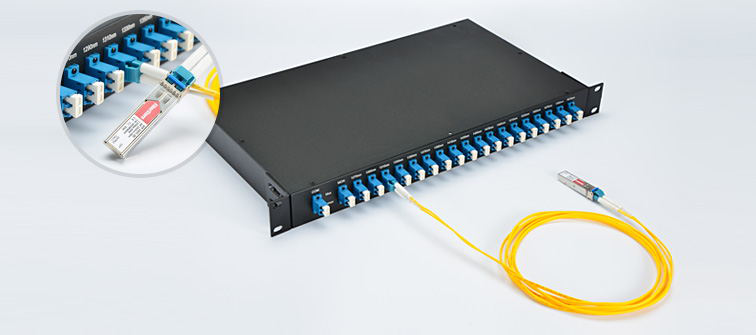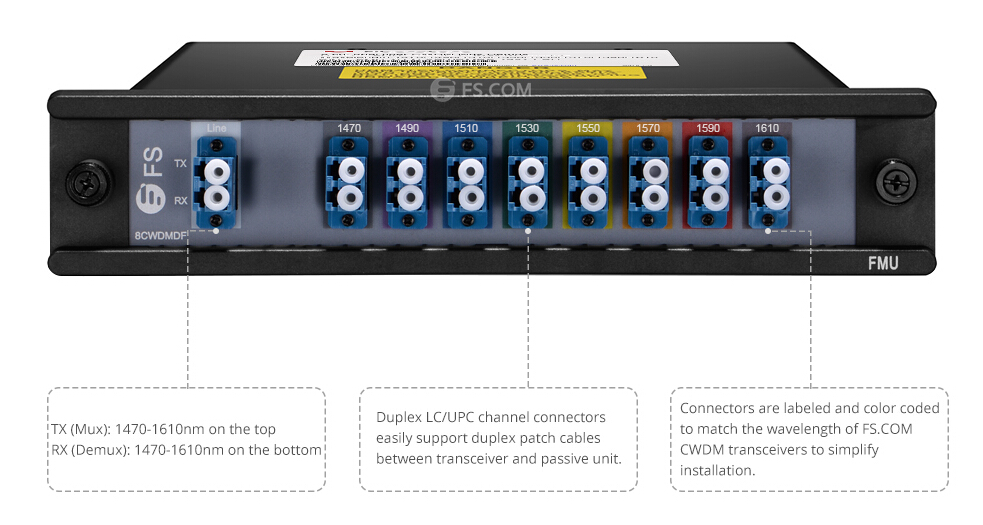With
the need for bandwidth increasing, the WDM (wavelength division
multiplexing) technology was developed to expand network capacity over a
single fiber. It uses a multiplexer (Mux) at the transmitter to combine
several signals together, and a demultiplexer (DeMux) at the receiver
to split them apart. Most WDM systems operate on 9µm single-mode fiber
optical cables. And they are divided into CWDM (coarse wavelength
division multiplexing) and DWDM (dense wavelength division
multiplexing). This article mainly focuses on CWDM system.
CWDM Mux/DeMux Overview
CWDM
is a technology which multiplexes multiple optical carrier signals on a
single optical fiber by using different wavelengths/colors of laser
light to carry different signals. In a CWDM system, the CWDM Mux/DeMux
is one of the most important component.
The
CWDM Mux/DeMux modules are passive optical solutions which are easy to
operate with a reliable low-maintenance design, and do not use power
supplies or electronics. They are designed to provide optical networking
support for high-speed Fibre Channel and Ethernet communication for MAN
(metropolitan area network) over a grid of CWDM optical wavelengths.
CWDM Mux/DeMux is capable of multiplexing and demultiplexing wavelengths
up to 18 channels from 1270 nm to 1610 nm in 20nm increments. Moreover,
it works seamlessly with transceivers to optimize link length, signal
integrity and network cost, and can be incorporated into a single
rack-mount solution for enhanced design, power and space efficiency.
Traditional CWDM Mux/DeMux System
Typically,
the CWDM Mux/DeMux modules interface to CWDM SFP/SFP+/XFP transceivers
on an attached FC SAN or network device. This chassis-based system
allows the addition of CWDM capability to any existing SAN or network
device that supports LC SFP/SFP+/XFP transceivers. In short, the CWDM
Mux/DeMux modules is connected with CWDM SFP/SFP+/XFP transceivers which
are inserted into the switch SFP/SFP+/XFP ports by using LC single-mode
patch cables.

The
CWDM transceivers are hot-swappable, field-replaceable devices that
adapt an electronic data signal to laser light at a specific wavelength.
Moreover, they are color-coded to indicate the wavelength and have a
color-coded clasp at one end. So the CWDM Mux/DeMux should be connected
with the CWDM transceivers with the same wavelength as each transceiver
will work only at the appropriate port and the data will always flow
between devices with the same wavelengths. For instance, the port on the
CWDM Mux/DeMux marked with 1470 nm, should be connected with the CWDM
transceiver that works over 1470nm wavelength. As CWDM Mux/DeMux
supports up to 18 different wavelengths, there are CWDM transceivers
working over these 18 wavelengths. The following table lists the
1000BASE-CWDM SFP (20km) transceivers as an example.
| Model ID | Wavelength | Description |
| 33979 | 1270 nm | 1000BASE-CWDM SFP 1270nm 20km DOM Transceiver |
| 37319 | 1290 nm | 1000BASE-CWDM SFP 1290nm 20km DOM Transceiver |
| 37321 | 1310 nm | 1000BASE-CWDM SFP 1310nm 20km DOM Transceiver |
| 37320 | 1330 nm | 1000BASE-CWDM SFP 1330nm 20km DOM Transceiver |
| 52674 | 1350 nm | 1000BASE-CWDM SFP 1350nm 20km DOM Transceiver |
| 52675 | 1370 nm | 1000BASE-CWDM SFP 1370nm 20km DOM Transceiver |
| 52676 | 1390 nm | 1000BASE-CWDM SFP 1390nm 20km DOM Transceiver |
| 52677 | 1410 nm | 1000BASE-CWDM SFP 1410nm 20km DOM Transceiver |
| 52678 | 1430 nm | 1000BASE-CWDM SFP 1430nm 20km DOM Transceiver |
| 52679 | 1450 nm | 1000BASE-CWDM SFP 1450nm 20km DOM Transceiver |
| 52680 | 1470 nm | 1000BASE-CWDM SFP 1470nm 20km DOM Transceiver |
| 52681 | 1490 nm | 1000BASE-CWDM SFP 1490nm 20km DOM Transceiver |
| 52682 | 1510 nm | 1000BASE-CWDM SFP 1510nm 20km DOM Transceiver |
| 52683 | 1530 nm | 1000BASE-CWDM SFP 1530nm 20km DOM Transceiver |
| 52684 | 1550 nm | 1000BASE-CWDM SFP 1550nm 20km DOM Transceiver |
| 52685 | 1570 nm | 1000BASE-CWDM SFP 1570nm 20km DOM Transceiver |
| 52686 | 1590 nm | 1000BASE-CWDM SFP 1590nm 20km DOM Transceiver |
| 52687 | 1610 nm | 1000BASE-CWDM SFP 1610nm 20km DOM Transceiver |
FMU Series CWDM Mux/DeMux System
FMU
CWDM Mux/DeMux modules are new types of modules launched by FS.COM.
Compared with the traditional CWDM Mux/DeMux modules, the new FMU series
modules are more user-friendly and show completely new characteristics.
With
low-profile modular design, the FMU CWDM Mux/DeMux modules plug into
one half of a 1RU, 19” rack mount chassis for simple installation and
modularity. This chassis based system allows a network equipment
manufacture to add CWDM capability to any existing networks with simple
pluggable interface. Besides, the equipment ports of the FMU CWDM
Mux/DeMux modules are color-coded to match the wavelengths of CWDM
transceivers to simplify installation and troubleshooting without having
to remove the transceivers from the local equipment. This color-coded
feature is the major advantage of this new FMU series modules and it do
greatly simplify the process of connecting a CWDM transceiver to its
associated device port. The following picture is an example of 8
channels 1470-1610nm dual fiber CWDM Mux/DeMux. This new FMU series CWDM
Mux/DeMux modules deliver dramatic cost savings to network equipment
manufacturers, enabling them to develop metro access systems that are
lower in cost, easier to provision and simpler to operate.

The following table lists FS.COM FMU series CWDM Mux/DeMux modules.
| Model ID | Description |
| 43554 | 4 channels 1470-1590nm single fiber CWDM Mux Demux |
| 43553 | 4 channels 1490-1610nm single fiber CWDM Mux Demux |
| 42972 | 4 channels 1270-1330nm dual fiber CWDM Mux Demux |
| 42944 | 4 channels 1510-1570nm dual fiber CWDM Mux Demux |
| 43780 | 8 channels 1290-1590nm single fiber CWDM Mux Demux |
| 43779 | 8 channels 1310-1610nm single fiber CWDM Mux Demux |
| 42945 | 8 channels 1290-1430nm dual fiber CWDM Mux Demux |
| 43097 | 8 channels 1470-1610nm dual fiber CWDM Mux Demux |
| 43711 | 9 channels 1270-1590nm single fiber CWDM Mux Demux |
| 43699 | 9 channels 1290-1610nm single fiber CWDM Mux Demux |
| 48393 | 4 channels 1470-1590nm single fiber CWDM Mux Demux with expansion port |
| 48394 | 4 channels 1490-1610nm single fiber CWDM Mux Demux with expansion port |
| 42973 | 4 channels 1510-1570nm dual fiber CWDM Mux Demux with expansion port |
| 43099 | 8 channels 1470-1610nm dual fiber CWDM Mux Demux with expansion port |
| 33489 | 18 channels 1270-1610nm dual fiber CWDM Mux Demux with monitor port |
| 30408 | 1RU Rack Mount Chassis unloaded, holds up to 2 units half 19''/1RU FMU Cassettes |
Note:
The modules with expansion port allows adding or expanding more CWDM
wavelengths/channels to the network for future upgrade. If used, it will
be treated just like the other ports and up-jacketed and terminated as
needed. If not used, it will be cut back into the module and terminated
in a way to reduce reflections.
Conclusion
Both
the traditional CWDM Mux/DeMux and the FMU series CWDM Mux/DeMux are
used to increase fiber network capacity without the expense of deploying
more fiber cables. They make full use of the low loss bandwidth of
optical fiber to achieve ultra high bit rate transmission. The key
difference is that it is more convenient and efficient for the FMU CWDM
Mux/DeMux to connect with the CWDM transceivers. FS.COM provides both
the two kinds of CWDM Mux/DeMux modules. For more details, you can visit
www.fs.com.
Originally published: www.fiberopticshare.com/traditional-cwdm-muxdemux-vs-fmu-series-cwdm-muxdemux.html
没有评论:
发表评论